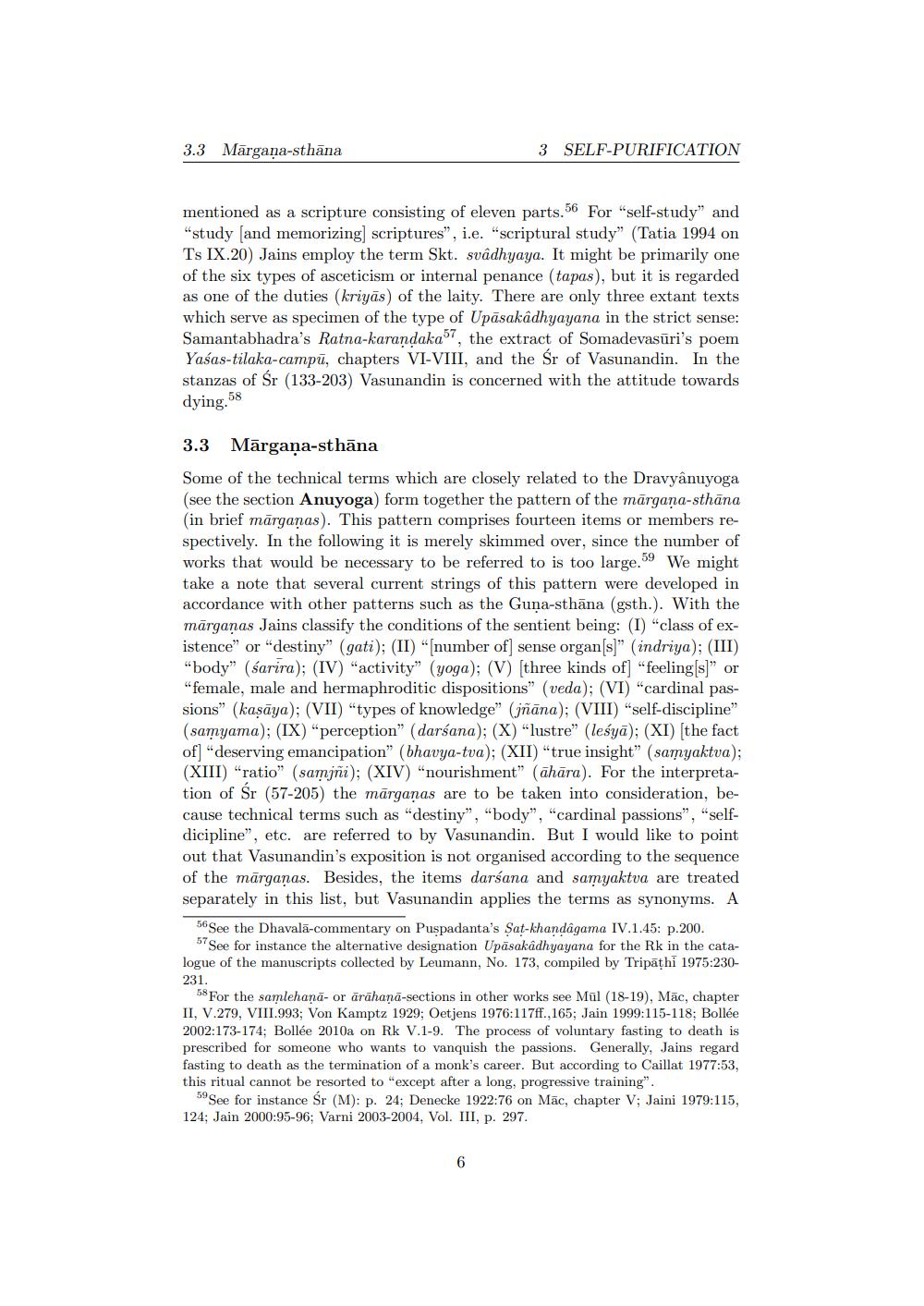________________
3.3 Märgana-sthāna
3 SELF-PURIFICATION
mentioned as a scripture consisting of eleven parts.56 For "self-study" and "study [and memorizing) scriptures", L.e. scriptural study" (Tatia 1994 on Ts IX.20) Jains employ the term Skt. svůdhyaya. It might be primarily one of the six types of asceticism or internal penance (tapas), but it is regarded as one of the duties (kriyās) of the laity. There are only three extant texts which serve as specimen of the type of Upasakâdhyayana in the strict sense: Samantabhadra's Ratna-karandaka57, the extract of Somadevasūri's poem Yasas-tilaka-campu, chapters VI-VIII, and the Śr of Vasunandin. In the stanzas of Śr (133-203) Vasunandin is concerned with the attitude towards dying, s
58
3.3 Märgana-sthāna
Some of the technical terms which are closely related to the Dravyânuyoga (see the section Anuyoga) form together the pattern of the margaṇa-sthāna (in brief marganas). This pattern comprises fourteen items or members respectively. In the following it is merely skimmed over, since the number of works that would be necessary to be referred to is too large. 59 We might take a note that several current strings of this pattern were developed in accordance with other patterns such as the Guna-sthāna (gsth.). With the marganas Jains classify the conditions of the sentient being: (I) "class of existence" or "destiny" (gati); (II) "[number of] sense organ[s]" (indriya); (III) "body" (sarira); (IV) "activity" (yoga); (V) (three kinds of] "feeling[s]" or "female, male and hermaphroditic dispositions" (veda); (VI) "cardinal pas sions" (kaşaya); (VII) "types of knowledge" (jana); (VIII) "self-discipline" (samyama); (IX) "perception" (darśana); (X) "lustre" (lesya); (XI) [the fact of] "deserving emancipation" (bhavya-tva); (XII) "true insight" (samyaktva); (XIII) "ratio" (samji); (XIV) "nourishment" (ahara). For the interpretation of Śr (57-205) the marganas are to be taken into consideration, because technical terms such as "destiny", "body", "cardinal passions", "selfdicipline", etc. are referred to by Vasunandin. But I would like to point out that Vasunandin's exposition is not organised according to the sequence of the marganas. Besides, the items darśana and samyaktva are treated separately in this list, but Vasunandin applies the terms as synonyms. A
56 See the Dhavala-commentary on Puspadanta's Sat-khandagama IV.1.45: p.200. 57 See for instance the alternative designation Upasakâdhyayana for the Rk in the catalogue of the manuscripts collected by Leumann, No. 173, compiled by Tripathi 1975:230231.
58 For the samlehaṇā- or ārāhaṇā-sections in other works see Mül (18-19), Mac, chapter II, V.279, VIII.993; Von Kamptz 1929; Oetjens 1976:117ff., 165; Jain 1999:115-118; Bollée 2002:173-174; Bollée 2010a on Rk V.1-9. The process of voluntary fasting to death is prescribed for someone who wants to vanquish the passions. Generally, Jains regard fasting to death as the termination of a monk's career. But according to Caillat 1977:53, this ritual cannot be resorted to "except after a long, progressive training".
59 See for instance Śr (M): p. 24; Denecke 1922:76 on Mac, chapter V; Jaini 1979:115, 124; Jain 2000:95-96; Varni 2003-2004, Vol. III, p. 297.
6




